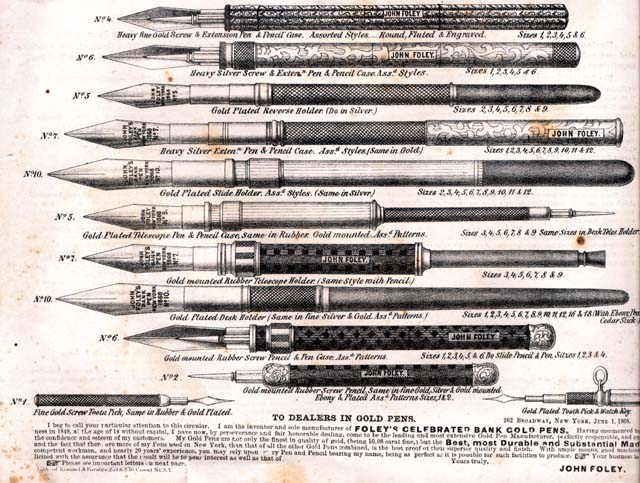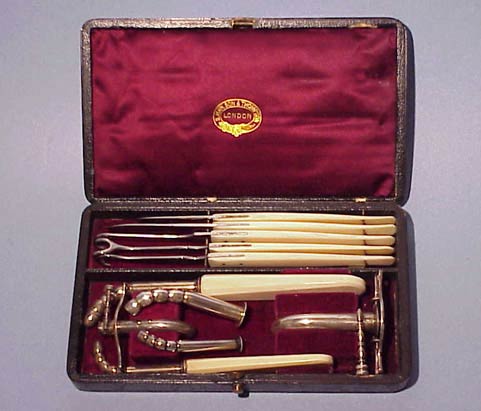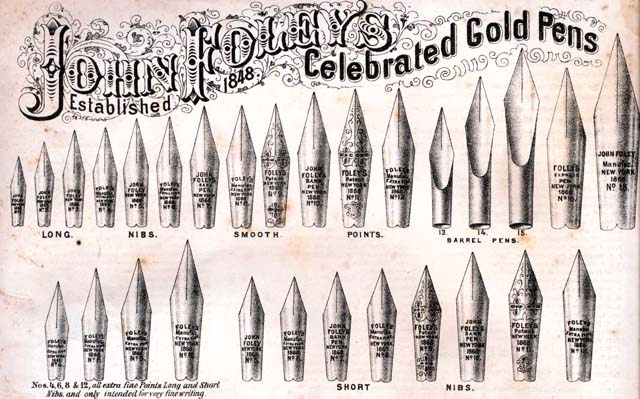
I nearly dropped my coffee. As I returned to my home office, I found my 3-year-old
son, Ren, playing with a pile of gold nibs on my office floor. I foolishly had
left them on my desk right in easy reach, and Ren was busy lining them up in single
file there on the floor.
“Look, Daddy. I made a train.” he yelled with glee. I told him that
those were not toys, as I quickly picked them up, checking each one to see if
they were damaged. Fortunately they all seemed fine. I yelled at Ren for taking
things from my desk when I wasn't there. Then I yelled at Keiko because she was
supposed to be watching him. Then I felt guilty for raising my voice, but a Waterman
#8 nib will make you crazy that way.
I forgot all about that nib incident for several months, but then it came back
to haunt me. It still does. While doing some research, I found a story that made
me feel sick. You see, Ren wasn't the first boy to find his father's pens.
In 1862 John Foley Jr., was nearly three and a half years old. His father,
John Foley Sr. was a self-made man and had created quite a name for himself in
the pen business. John Sr. was proud of his work and liked to tell how he entered
the pen business as a young boy of 14, working the grinders and climbed his way
up. In 1853, just five years after opening his own pen business, Foley won the
coveted gold medal at the New York International Industry Exhibition. This is
not so surprising. Foley learned what he knew from Levi Brown who was a partner
with Reverend A. Cleveland, who had bought the patent rights for iridium tipping
of pens in the late 1830’s from Sir Isaac Hawkins. (Please refer to my PENnant
Article “Iridium Kiss”) This was a huge advancement over the steel
nibs of the day, which were sold by the gross and wore out with a few uses. The
Foley’s moved up quickly and now resided in a nice home in New York's affluent
Lexington Avenue area. Yes, things were looking good for the Foleys, but often
that is when tragedy strikes.

Foley pens from a1853 Foley Pamphlet
On Monday morning, May 7th 1862, John Sr. took his boy with him to see the
pen factory and had a worker return the boy later the same morning. But something
was wrong. Mrs. Foley noted that little John had trouble talking and didn’t
want to eat his lunch. However the boy was interested in playing with his brothers
and sisters, and she didn’t think too much about it.
John Jr’s condition grew steadily worse, and his parents thought he had
a bad cough or summer cold. Something to worry about to be sure, but no reason
for alarm. However, when the Foleys checked on their son that night, they were
shocked to see that little John was turning blue. He coughed painfully, and he
was breathing with great difficulty.
Dr. William H. Van Buren (nephew of President Martin Van Buren) was called and
he quickly arrived at the Foley residence. He examined the boy and was worried.
He diagnosed an obstruction and for an hour tried to remove the obstruction but
without success. He couldn’t even see what it was let alone reach it. Frustrated,
he looked at the boy and saw that his condition was growing worse.
Today the obvious answer is a tracheotomy. Even in 1862, the procedure was not
at all new. Egyptian texts first mention the procedure in 3600 B.C. Nevertheless
in the Civil War era, Trachs were still not a standard procedure. They were seen
as a last ditch effort to save a suffocating person, and nearly always administered
far too late to save the person. In the 1860’s the survival rate for tracheotomies
was less than 25 percent. And Dr. Van Buren was not in a hurry to perform the
procedure. He sent for Dr. George Elliot to come and give his opinion.
Dr. Elliot concurred with Dr. Van Buren. It was growing obvious that the child
would die in a few hours if they did not do something. They explained the idea
of the tracheotomy to the Foleys. Mrs Foley begged them to try it...and to do
it quickly.

Ivory tracheotomy set circa 1860
Dr. Van Buren started boiling his instruments, while Dr. Elliot ran to the
homes of Dr.’s Foster, Swift and Hawthorn and told them to come quickly
and assist.
Once they had everything ready, the team of doctors began the procedure a little
past 10:00 pm. They used chloroform to put the boy to sleep. Working with just
the light from a kerosene lamp, Dr. Van Buren made the incision. Just before he
inserted the trach tube, he noticed a glint of gold in the dim light. With a pair
of forceps he removed a small gold nib from the boy’s throat. Dr. Van Buren
proceeded with inserting the silver tube and instantly the boy’s breathing
became relaxed and within moments his color returned.
I can feel John Foley’s pain and shame as Dr. Van Buren held up the gold
nib for the other doctors to see. Any father can understand that. I thank God
now that nothing happened to my son, and I will never leave gold nibs within his
reach.

Illustration of available pen points
from the1853 Foley Pamphlet
Little John quickly recovered and a week later, on the morning of the 18th,
the same team of doctors were present as Dr. Van Buren removed the tube. Little
John grew up strong and eventually took over his father’s pen company. I
just wonder what became of that gold nib. Did Dr. Van Buren keep it as a souvenir
or did little John keep it as a good luck piece?
 Ron
Dutcher has lived in Japan for over 15 years, where he owns and runs a small orthopedic
clinic with his wife, Keiko; which leads him to many Japanese pen finds. His patients,
once they learn of his pen hobby often give him pens as gifts or offer to sell
them to him. He is a member of the Tokyo Pen Association, and has learned a great
deal from Japanese pen collectors. He sells a great many Japanese pens on ebay
under the name Kamakura-Pens, but his true love is for early American pens. He
can be contacted at rd@kamakurapens.com Ron
Dutcher has lived in Japan for over 15 years, where he owns and runs a small orthopedic
clinic with his wife, Keiko; which leads him to many Japanese pen finds. His patients,
once they learn of his pen hobby often give him pens as gifts or offer to sell
them to him. He is a member of the Tokyo Pen Association, and has learned a great
deal from Japanese pen collectors. He sells a great many Japanese pens on ebay
under the name Kamakura-Pens, but his true love is for early American pens. He
can be contacted at rd@kamakurapens.com
|